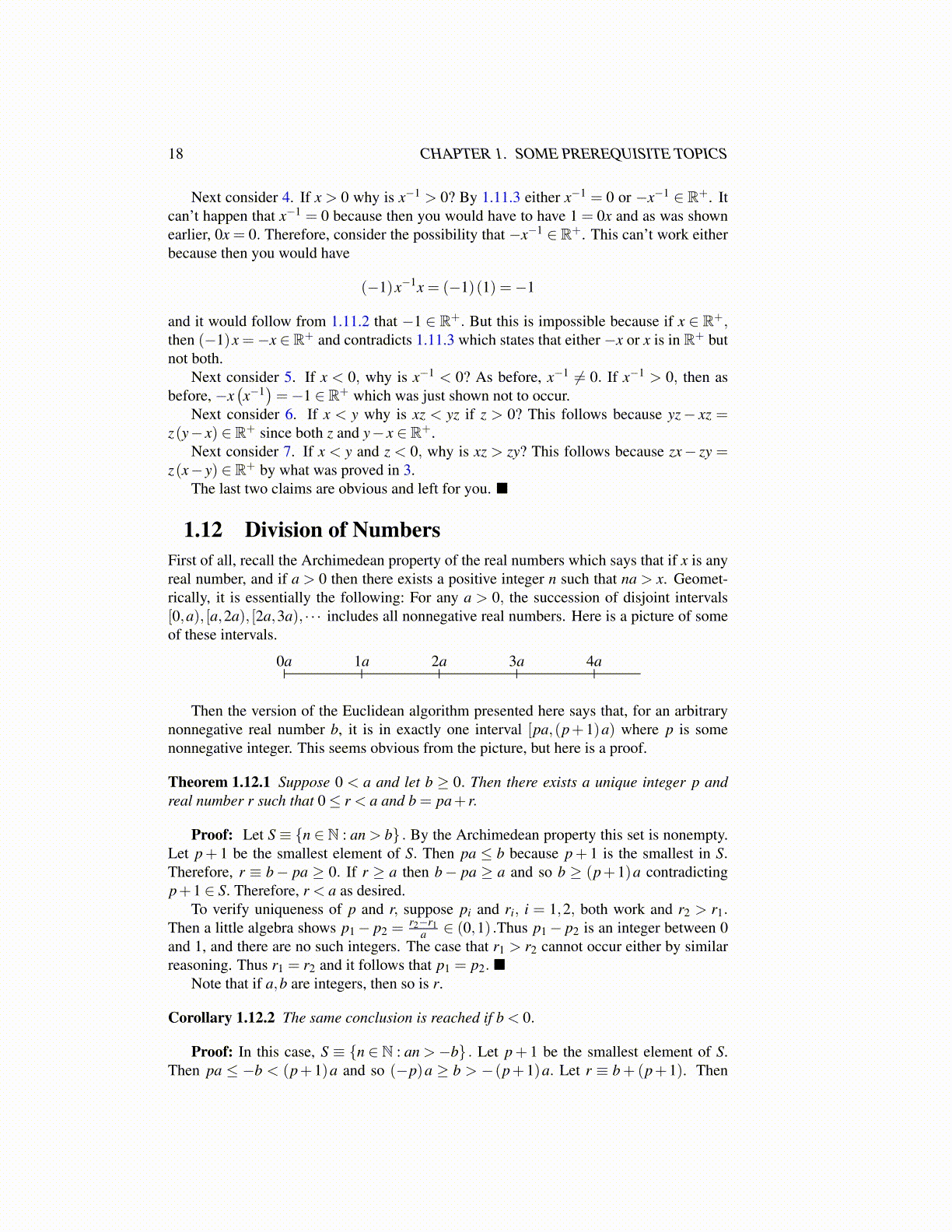
18 CHAPTER 1. SOME PREREQUISITE TOPICS
Next consider 4. If x > 0 why is x−1 > 0? By 1.11.3 either x−1 = 0 or −x−1 ∈ R+. Itcan’t happen that x−1 = 0 because then you would have to have 1 = 0x and as was shownearlier, 0x = 0. Therefore, consider the possibility that −x−1 ∈ R+. This can’t work eitherbecause then you would have
(−1)x−1x = (−1)(1) =−1
and it would follow from 1.11.2 that −1 ∈ R+. But this is impossible because if x ∈ R+,then (−1)x =−x ∈R+ and contradicts 1.11.3 which states that either −x or x is in R+ butnot both.
Next consider 5. If x < 0, why is x−1 < 0? As before, x−1 ̸= 0. If x−1 > 0, then asbefore, −x
(x−1)=−1 ∈ R+ which was just shown not to occur.
Next consider 6. If x < y why is xz < yz if z > 0? This follows because yz− xz =z(y− x) ∈ R+ since both z and y− x ∈ R+.
Next consider 7. If x < y and z < 0, why is xz > zy? This follows because zx− zy =z(x− y) ∈ R+ by what was proved in 3.
The last two claims are obvious and left for you. ■
1.12 Division of NumbersFirst of all, recall the Archimedean property of the real numbers which says that if x is anyreal number, and if a > 0 then there exists a positive integer n such that na > x. Geomet-rically, it is essentially the following: For any a > 0, the succession of disjoint intervals[0,a), [a,2a), [2a,3a), · · · includes all nonnegative real numbers. Here is a picture of someof these intervals.
0a 1a 2a 3a 4a
Then the version of the Euclidean algorithm presented here says that, for an arbitrarynonnegative real number b, it is in exactly one interval [pa,(p+1)a) where p is somenonnegative integer. This seems obvious from the picture, but here is a proof.
Theorem 1.12.1 Suppose 0 < a and let b ≥ 0. Then there exists a unique integer p andreal number r such that 0≤ r < a and b = pa+ r.
Proof: Let S ≡ {n ∈ N : an > b} . By the Archimedean property this set is nonempty.Let p+ 1 be the smallest element of S. Then pa ≤ b because p+ 1 is the smallest in S.Therefore, r ≡ b− pa ≥ 0. If r ≥ a then b− pa ≥ a and so b ≥ (p+1)a contradictingp+1 ∈ S. Therefore, r < a as desired.
To verify uniqueness of p and r, suppose pi and ri, i = 1,2, both work and r2 > r1.Then a little algebra shows p1− p2 =
r2−r1a ∈ (0,1) .Thus p1− p2 is an integer between 0
and 1, and there are no such integers. The case that r1 > r2 cannot occur either by similarreasoning. Thus r1 = r2 and it follows that p1 = p2. ■
Note that if a,b are integers, then so is r.
Corollary 1.12.2 The same conclusion is reached if b < 0.
Proof: In this case, S ≡ {n ∈ N : an >−b} . Let p+ 1 be the smallest element of S.Then pa ≤ −b < (p+1)a and so (−p)a ≥ b > −(p+1)a. Let r ≡ b+(p+1). Then